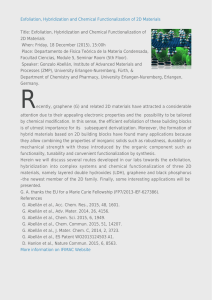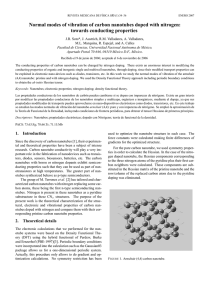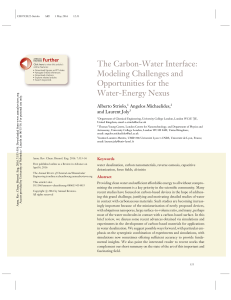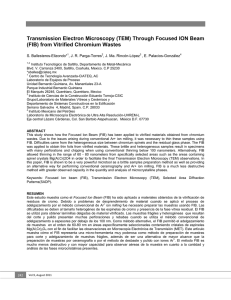Side-Wall Functionalization of Multi
Anuncio
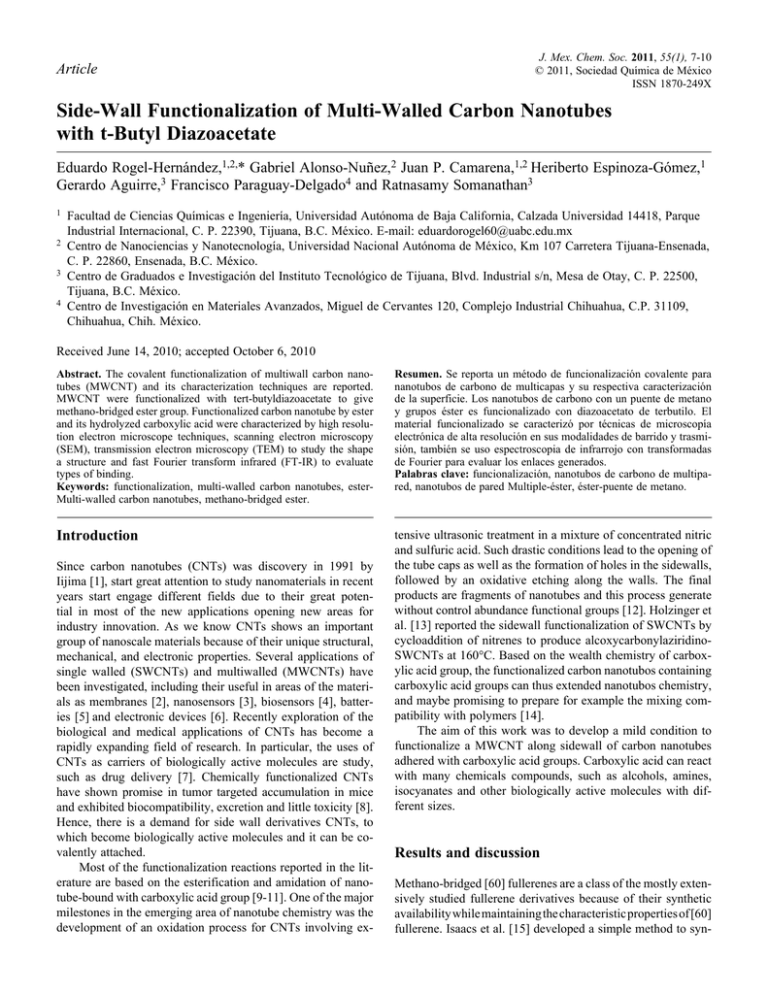
Side-Wall Article Functionalization of Multi-Walled Carbon Nanotubes with t-Butyl Diazoacetate J. Mex. Chem. Soc. 2011, 55(1), 7-10 © 2011, Sociedad Química de México ISSN 1870-249X Side-Wall Functionalization of Multi-Walled Carbon Nanotubes with t-Butyl Diazoacetate Eduardo Rogel-Hernández,1,2,­* Gabriel Alonso-Nuñez,2 Juan P. Camarena,1,2 Heriberto Espinoza-Gómez,1 Gerardo Aguirre,3 Francisco Paraguay-Delgado4 and Ratnasamy Somanathan3 1 Facultad de Ciencias Químicas e Ingeniería, Universidad Autónoma de Baja California, Calzada Universidad 14418, Parque Industrial Internacional, C. P. 22390, Tijuana, B.C. México. E-mail: [email protected] 2 Centro de Nanociencias y Nanotecnología, Universidad Nacional Autónoma de México, Km 107 Carretera Tijuana-Ensenada, C. P. 22860, Ensenada, B.C. México. 3 Centro de Graduados e Investigación del Instituto Tecnológico de Tijuana, Blvd. Industrial s/n, Mesa de Otay, C. P. 22500, Tijuana, B.C. México. 4 Centro de Investigación en Materiales Avanzados, Miguel de Cervantes 120, Complejo Industrial Chihuahua, C.P. 31109, Chihuahua, Chih. México. Received June 14, 2010; accepted October 6, 2010 Abstract. The covalent functionalization of multiwall carbon nanotubes (MWCNT) and its characterization techniques are reported. MWCNT were functionalized with tert-butyldiazoacetate to give methano-bridged ester group. Functionalized carbon nanotube by ester and its hydrolyzed carboxylic acid were characterized by high resolution electron microscope techniques, scanning electron microscopy (SEM), transmission electron microscopy (TEM) to study the shape a structure and fast Fourier transform infrared (FT-IR) to evaluate types of binding. Keywords: functionalization, multi-walled carbon nanotubes, esterMulti-walled carbon nanotubes, methano-bridged ester. Resumen. Se reporta un método de funcionalización covalente para nanotubos de carbono de multicapas y su respectiva caracterización de la superficie. Los nanotubos de carbono con un puente de metano y grupos éster es funcionalizado con diazoacetato de terbutilo. El material funcionalizado se caracterizó por técnicas de microscopía electrónica de alta resolución en sus modalidades de barrido y trasmisión, también se uso espectroscopia de infrarrojo con transformadas de Fourier para evaluar los enlaces generados. Palabras clave: funcionalización, nanotubos de carbono de multipared, nanotubos de pared Multiple-éster, éster-puente de metano. Introduction tensive ultrasonic treatment in a mixture of concentrated nitric and sulfuric acid. Such drastic conditions lead to the opening of the tube caps as well as the formation of holes in the sidewalls, followed by an oxidative etching along the walls. The final products are fragments of nanotubes and this process generate without control abundance functional groups [12]. Holzinger et al. [13] reported the sidewall functionalization of SWCNTs by cycloaddition of nitrenes to produce alcoxycarbonylaziridinoSWCNTs at 160°C. Based on the wealth chemistry of carboxylic acid group, the functionalized carbon nanotubos containing carboxylic acid groups can thus extended nanotubos chemistry, and maybe promising to prepare for example the mixing compatibility with polymers [14]. The aim of this work was to develop a mild condition to functionalize a MWCNT along sidewall of carbon nanotubes adhered with carboxylic acid groups. Carboxylic acid can react with many chemicals compounds, such as alcohols, amines, isocyanates and other biologically active molecules with different sizes. Since carbon nanotubes (CNTs) was discovery in 1991 by Iijima [1], start great attention to study nanomaterials in recent years start engage different fields due to their great potential in most of the new applications opening new areas for industry innovation. As we know CNTs shows an important group of nanoscale materials because of their unique structural, mechanical, and electronic properties. Several applications of single walled (SWCNTs) and multiwalled (MWCNTs) have been investigated, including their useful in areas of the materials as membranes [2], nanosensors [3], biosensors [4], batteries [5] and electronic devices [6]. Recently exploration of the biological and medical applications of CNTs has become a rapidly expanding field of research. In particular, the uses of CNTs as carriers of biologically active molecules are study, such as drug delivery [7]. Chemically functionalized CNTs have shown promise in tumor targeted accumulation in mice and exhibited biocompatibility, excretion and little toxicity [8]. Hence, there is a demand for side wall derivatives CNTs, to which become biologically active molecules and it can be covalently attached. Most of the functionalization reactions reported in the literature are based on the esterification and amidation of nanotube-bound with carboxylic acid group [9-11]. One of the major milestones in the emerging area of nanotube chemistry was the development of an oxidation process for CNTs involving ex- Results and discussion Methano-bridged [60] fullerenes are a class of the mostly extensively studied fullerene derivatives because of their synthetic availability while maintaining the characteristic properties of [60] fullerene. Isaacs et al. [15] developed a simple method to syn- J. Mex. Chem. Soc. 2011, 55(1) thesize methano-bridged fullerenes by reaction with alkyl diazoacetates. Using the same technique we derivatized CNTs using tert-butyl diazetate to give methano acetate bridged with CNT. Figure 1 shows the TEM micrograph as MWCNT were prepared by spray pyrolysis technique, it can be notice the side wall is clear, these types of CNTs was used for functionalized purpose. The number of walls changes among them between 50 and 70 layers. Figures 2a, 2b and 2c show FT-IR spectra from, cleavage of protecting group of the methano bridged, methano bridged ester, and as grown MWNT, respectively. The FT-IR spectra confirm that MWNT reacted chemically with t-butyl diazoacetate after reflux process. Figure 2c shows signal peaks from pristine as grown MWNTs, this spectra shows clearly the comparison among the functionalized nanotubes at different stages. For the MWNT-ester (Figure 2b), three main peaks were observed. The peak at 1738 cm-1 corresponds to carbonyl stretching COOtBu; then the others two peaks, at 2874 and 2918 cm-1, indicates sp3 carbon-hydrogen stretching. In the case of MWCNT-COOH (Figure 2a), can be notice evidently two signals, one of them a broad absorption at 3368 cm-1 indicates OH stretching frequency of COOH and at 1745 cm-1 indicates carbonyl stretching in COOH. Morphology of functionalized CNTs was studied by electron microscopy techniques in scanning and transmission mode shows generally the tubular structure of carbon nanotubes, it is well retained after functionalization, showing the method is a mild condition. Figure 3 shows SEM images at low and high magnification respectively, it can be observe the CNTs do not suffer damage after the functionalization process, Figure 3a shows a typical morphology of CNTs, they remains uniform, at higher magnification Figure 3b, the image shows a few conglomeration on the surface which was adhered on 100 nm Fig. 1. TEM image from MWCNTs as obtained by spray pyrolysis technique. Eduardo Rogel-Hernández et al. Fig. 2. FT-IR spectra of functionalized MWCNT: (a) nanotubeCHCOOH (b) nanotube-CHCOO-t-Bu and (c) pristine CNTs. the carbon nanotube. Figure 4a shows TEM micrographs there are a small particles affix on the surface of CNTs, they were clearly identified in the dark field image mode as show in the Figure 4b this image was acquired with High Angle Annular Dark Field (HAADF) detector, these are a conglomerate of particles and the diameter size are around 40 nm in average; the conglomerate particles can be notice clearly on the Figure 4c, each particle is less than 5 nm. This micrograph shows the iron in the middle of the tube, it is coming from the ferrocene catalyst used for CNTS synthesis [16]. The Figure 4d shows selected area electron diffraction, it can be notice symmetrical intensity spots and rings. The near close to the center symmetric spots belongs to 3.4 Å interplanar distance (IP), then the first ring belong to 2.05 Å IP, then the next symmetric spots belongs to 1.7 Å IP and second ring belongs to 1.16 Å IP, these values belongs to carbon graphite. Finally the Figure 4e shows high resolution image of MWCNT, it can be notice de distance between layers, this image shows internal radio of the 10 nm and external radio of 50 nm. At the same image we can see the CNT layers are in good condition, they are not suffering damage by this way functionalization process. Conclusions We have described the functionalization of multi-wall carbon nanotubes with tert-butyl diazoacetate and subsequent cleavage of the ester group. The carbon nanotubes functionalized were Side-Wall Functionalization of Multi-Walled Carbon Nanotubes with t-Butyl Diazoacetate (d) (c) Fig. 3. SEM Micrographs of MWCNT functionalized by ester (a) low magnification, (b) high magnification. They show material adhered on the CNTs. fully characterized by a combination of Analytical technical. HRTEM and HRSEM show the presence of ester group a long of the carbon nanotubes. The FT-IR spectroscopy reveals the presence of ester group and the carboxylic acid, which is assumed the assembly of carbon nanotubes. We have demonstrated this reactive is a good method to functionalize carbon nanatubes with chemical and biological compounds. (e) Experimental Ferrocene (Sigma-Aldrich, 98%) and tert-butyl diazoacetate (Sigma-Aldrich) were used without further purification. Solvents were purified by standard methods. Boron Tribromide (Aldrich) solution was preparated in dichloromethane (1 M). Infrared spectra were recorded with NaCl disks on a Perkin-Elmer Spectrum One spectrophotometer, Transmission Electron micrographs were obtained using a JEOL 2010F analytical TEM microscope operated at 200kV and JEOL JSM7401F SEM with cold cathode field emission gun. Preparation of multi walled carbon nanotubes MWCNTs were synthesized by spray pyrolysis technique using toluene/ferrocene mixture in a heated Vycor tube as it was de- Fig. 4. TEM Micrographs of functionalized MWCNT by ester: (a) low magnification (b) HAADF, (c) high magnification, (d) diffraction pattern and (e), high resolution TEM. scribed by Alonso Núñez et al. [17], dimension of the tube are 9 mm diameter and 230 mm length connected to a pneumatic system acting as solution atomizer. The tube was heated by a cylindrical furnace (Thermolyne 1200) with a high precision 10 J. Mex. Chem. Soc. 2011, 55(1) Eduardo Rogel-Hernández et al. + N N C CH3 COOCCH3 H H CH3 C COOCCH3 CH3 + N2 CH3 1)B Br3 -10°C, 1h 2)25°C, 2h B rC(CH3)3 + H C COOH Fig. 5. Synthesis of MWCNT-ester and cleavage of the ester group. temperature controller (±1°C). A mixture of 25 mL of toluene (Aldrich, 99.8%) and 1.0 g of ferrocene was fed for 15 min into the tube using argon (Praxair, 99.99%) as carrier gas after the temperature had stabilized at 900°C. The flow rate was regulated by a mass flow controller to be 83.3 cm3/s. The black film of MWCNTs were formed at the inside surface of the Vycor tube, it was removed mechanically by scraping and observed by electron microscopes. For TEM the specimens were prepared by dispersing the carbon film in acetone and sonicated it for 2 min. Then a drop of the suspension was put onto a Cu grid coated with a holey carbon film and allowed to dry in air; the TEM micrograph is show in the Figure 1. Functionalization of carbon nanotubes It was carried out following a methodology similar to that established by Isaacs et al. [15] (Figure 5). In a typical experiment, 10 mg of MWCNTs were dispersed in toluene (previously purified under NaH). This suspension was sonicated for 3 min and then it was added with tert-butyl diazoacetate (50μL), the reaction mixture was place to reflux for 24 h. The reaction mixture was filtered and washed with toluene and drying over vacuum. The structural change resulting material was characterized by electron microscopy and spectroscopy FT-IR techniques. Cleavage of protecting groups The cleavage of protecting groups of the methano-bridged MWNT was carried out following a methodology similar to reported by Arthur M. Felix [18] (Figure 5). In a typical procedure, a MWCNT-ester (9 mg) was added in CH2Cl2 and dispersed it by sonication (3 min) then it was cooled at -10°C and 5 mL of 1M BBr3 in CH2Cl2 was added dropwise with constant stirring. After that, it was remaining at -10°C for 1 h more and then the temperature was increase up to 25°C and it remaining for 24 h. The reaction was finished by careful dropwise addition of water. The product was filtered and washed with water and CH2Cl2 and the material was dry under vacuum. The resulting changes in the CNTs were characterized by spectroscopy FT-IR. Acknowledgements We are gratefully thanks to the academic technicians W. Antunez and C. Ornelas from the Laboratorio Nacional de Nanotecnologia located at CIMAV, Chihuahua, México, E. Flores from CNyN. Thanks to the Universidad Autónoma de Baja California (UABC) for financial support under the project 3864 and Project PAPIT-DGAPA IN102509-3. References 1.Iijima, S. Nature 1991, 354, 56-58. 2.Hinds, B.J.; Chopra, N.; Rantell, T.; Andrews, R.; Gavalas, V.; Bachas, L.G. Science 2004, 303, 62-65. 3.Goldoni, A.; Larciprete, R.; Petaccia, L.; Lizzit, S. J. Am. Chem. Soc. 2003, 125, 11329-11333. 4.Wang, J.; Musamech, M.; lin, Y. J. Am. Chem. Soc. 2003, 125, 2408-2409. 5.Che, G.; Lakschmi, B.B.; Fisher, E.R.; Martin, C.R. Nature, 1998, 393, 346-349. 6.Liang, W.; Bockrath, M.; Bozovic, D.; Hafner, J.H.; Tinkham, M.; Park, H. Nature 2001, 411, 665-669. 7.Blanco, A.; Kostarelos, K.; Prato, M. Curr. Opin. Chem. Bio. 2005, 9, 674-679. 8.Liu, Z.; Chen, K.; Davis, C.; Sherlock, S.; Cao, Q.; Chen, X.; Dai, H. Cancer Res. 2008, 68, 6652-6660. 9.Wong, S.S.; Woolly, A.T.; Joselevich, E.; Cheung, C.L.; Lieber, C.M. J. Am. Chem. Soc. 1998, 120, 8557-8558. 10.Coleman, K.S.; Bailey, S.R.; Fogden, S.; Green, M.L.H. J. Am. Chem. Soc. 2003, 125, 8722-8723. 11.Zhao, C.; Ji, L.; Liu, H.; Hu, G.; Zhang, G.; Zhang, S.; Yang, M.; Yang, Z. J. Solid State Chem. 2004, 177, 4394-4398. 12.Zhang, J; Zou, H.; Qing, Q.; Yang, Y.; Li, Q.; Liu, Z.; Guo, X.; Du, Z. J. Phys. Chem. B 2003, 107, 3712-3718. 13.Holzinger, M.; Vostrowsky, O.; Hirsch, A.; Hennrich, F.; Kappes, M.; Weiss, R.; Jellen, F. Angew. Chem. Int. Ed. 2001, 40, 40024005. 14.Hill, D.E.; Lin, Y.; Rao, A.M.; Allard, L.F.; Sun, Y.P. Macromolecules 2002, 35, 9466-9471. 15.Isaacs, L.; Wehrsing, A.; Diederich, F. Helv.Chim. Acta 1993, 76, 1231-1250. 16.Lara-Romero, J.; Alonso-Núñez, G.; Jiménez-Sandoval, S.; Avalos-Borja, M. J. Nanosci. Nanotechnol. 2008, 8, 6509-6512. 17.Alonso-Núñez, G.; Lara-Romero, J.; Paraguay-Delgado, F.; Sanchez-Castañeda, M.; Jiménez-Sandoval, S. J. Exp. Nanosci. 2010, 5, 52-60. 18.Felix, A. M. J. Org. Chem. 1974, 39, 1427-1429.
